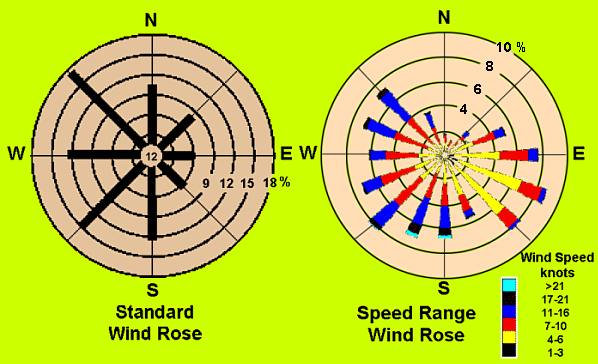 |
 |
| Home | Welcome | What's New | Site Map | Glossary | Weather Doctor Amazon Store | Book Store | Accolades | Email Us |
 | |||||||||||||||
Weather Almanac for March 2005BY ANY OTHER NAME: THE WIND ROSELast month (February 2005), I wrote about a new discovery for me: the frost flower. However, another meteorological blossom has long been a part of my weather knowledge and practice: the wind rose. The wind rose has a long history and played an important role in early marine navigation, preceding the magnetic compass as an indicator of sailing directions on a chart through the depictions of local prevailing winds. I'll get to the history later, but first I will define the wind rose.
These diagrams resemble the petals of a flower, and thus became known as wind roses, though I have seen plots that looked more like daisies, tulips and even an iris or two. Many variations exist in this era of data analysis. The most common variant indicates the frequency of wind speed ranges from each direction. Other variations represent not only wind direction and speed frequencies around the compass but often relate wind directions with other weather occurrences such as frequency of fog or air pollution levels with the given compass directions. Early wind roses displayed 8-and 16-point roses for ease of reading them below decks in early sailing ships. More elaborate map roses showed 32 points for the classically named wind directions. For years, weather records only observed wind directions by the 8 or 16 point compass, but today, digital reporting of wind direction to the nearest degree allows roses to be constructed with a level of detail depending on the application. A wind rose can display any time period desired, from a single day to decades, but the most common indicate prevailing winds for the given location over the climate normal period of 30 years. Below is an example (left hand panel) of a basic wind rose constructed from an 8-point compass, the four cardinal directions (N, E, S, W) and the four intermediate directions (NE, SE, SW, NW). Each arm or petal of the rose covers wind directions falling within plus-or-minus 22.5 degrees from the central direction (e.g., NW). Wind roses lose some of their flowery demeanor when statistics are added to the rose such as the wind rose with speed intervals (right hand panel) where the frequency of wind speed categories (indicated by the width of the line) within that particular direction are plotted.  History of the Wind RoseThe wind rose has been with us for millennia, the first attributed to pre-Christian times. Some historians believe the Etruscans used an eight-point wind rose as early as the 4th Century BCE. Also in this century, Timosthenes, a chief pilot of the Egyptian fleet, devised a wind-rose for his navigation maps.
One of the earliest physical benchmarks is the famous Tower of the Winds which stands in Athens. Constructed around 50 BCE, by the Greek architect and astronomer Andronikos of Kyrrhos, the octagonal tower shows each of the eight "wind gods" on the side of the tower from which the blow. For this reason, meteorologists continue to speak of winds in terms of their origin, not their destination — e.g., a "westerly" wind blows from west to east.
The compass rose (as the wind rose was known on early navigation charts) became common on charts and maps beginning around the 14th Century. The most elaborate wind roses had 32 points, simple, multiple bisections of the four cardinal wind directions, that kept with the tradition of the 32 classically named winds. Maritime historians credit 15th Century Portuguese navigators with improving the rose to a sixteen-point wind rose as they ushered in the golden age of maritime exploration. The 16-and 8-point roses were far more legible for mariners who often had to read these charts in dim light and bad weather on heaving ship decks. Adding colours and quickly recognized symbols aided in the chart's clarity. No standard format existed for drafting compass roses, so each cartographic house produced their own stylization. For example around the time of Columbus' voyages, Portuguese map-maker Pedro Reinel drew the first 32-point compass rose with a fleur de lis symbol pointed North — derived from a north arrow — and letter T, for Tramontana, a cool northerly Mediterranean wind. A Maltese cross denoted East because that direction had religious and cosmological significance (the direction of Jerusalem). The eight prime compass points were coloured black, the intermediate half-directions blue or green, and the quarter winds in red.
Wind roses from these earlier times were not only useful tools for mariners but often were also elaborate works of graphic arts. Today, most wind roses are utilitarian in their design, simple polar graphs. But there are interesting, supersized wind roses that are so common, you might not recognize them. Where are they? If you travel by air, look at the airports you pass over. Their runways are aligned in the directions of the most frequent winds, and thus form the main arms of a partial wind rose on the ground. The Weather Doctor's Weather Almanac By Any Other Name: The Wind Rose
|
|||||||||||||||
 |
To Purchase Notecard, |
Now Available! Order Today! | |
 |
 |
NEW! Now |
The BC Weather Book: |


